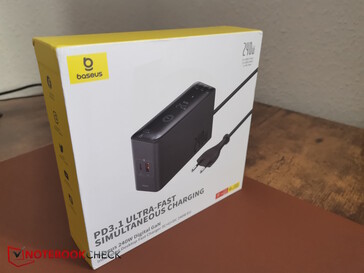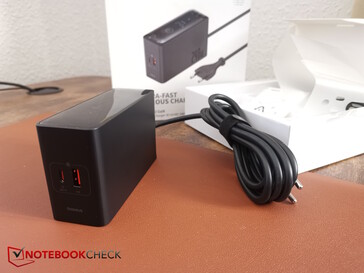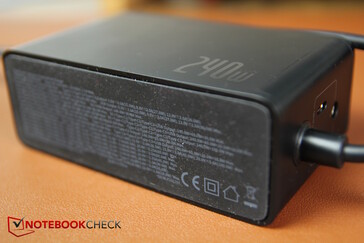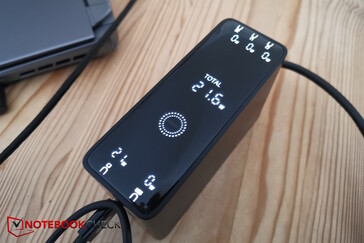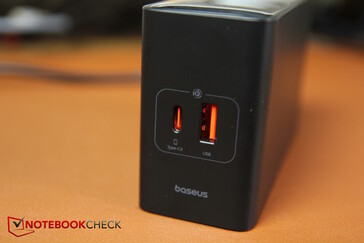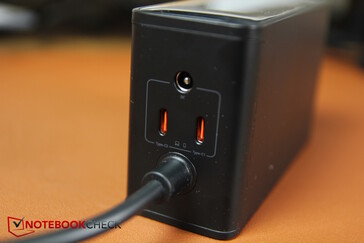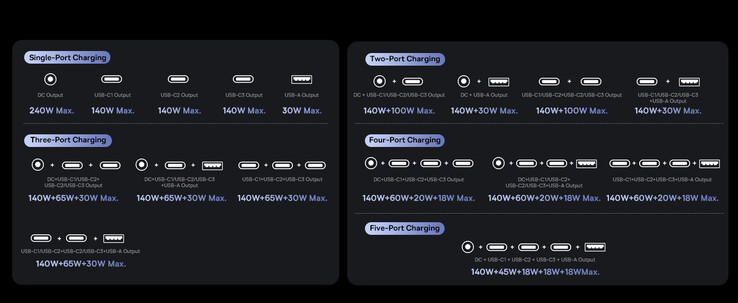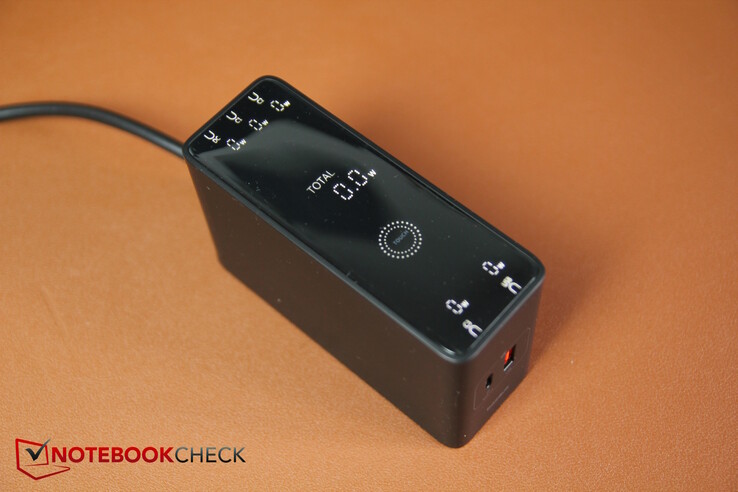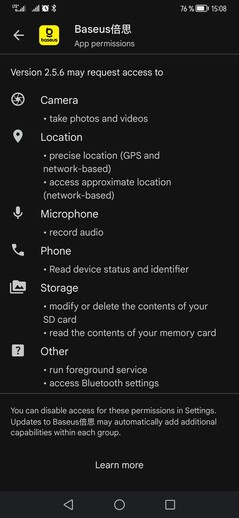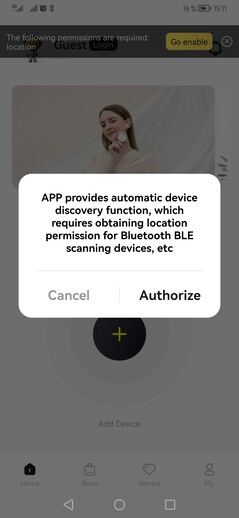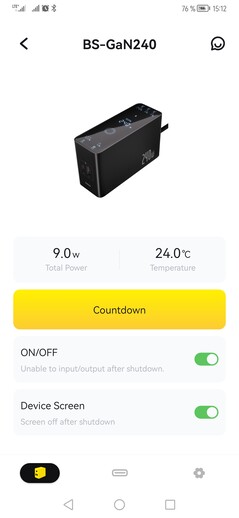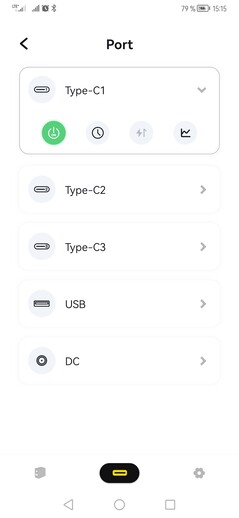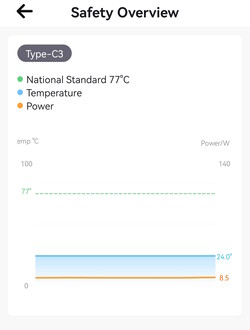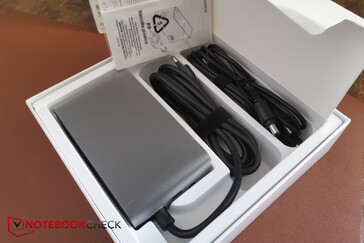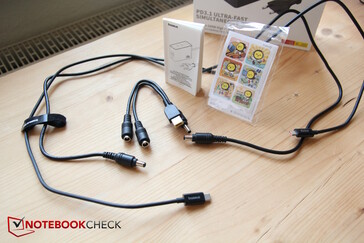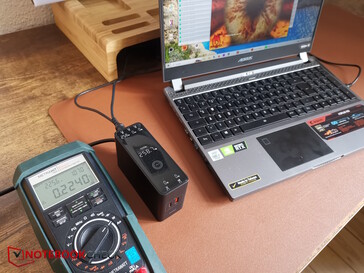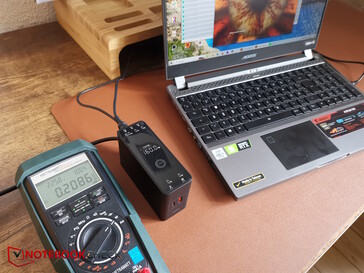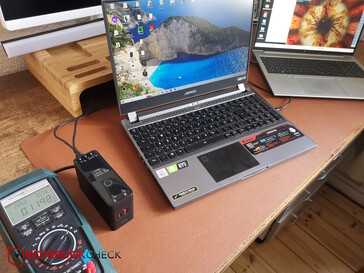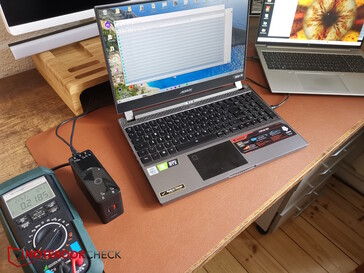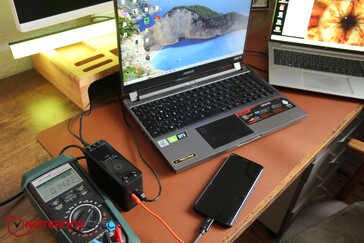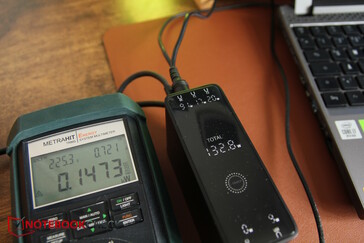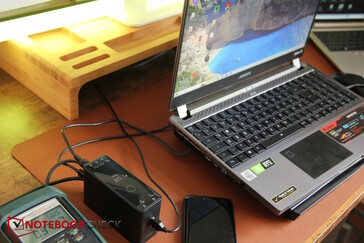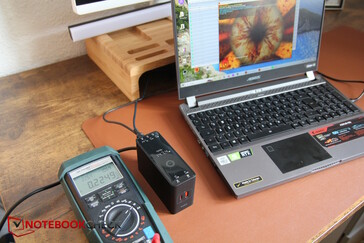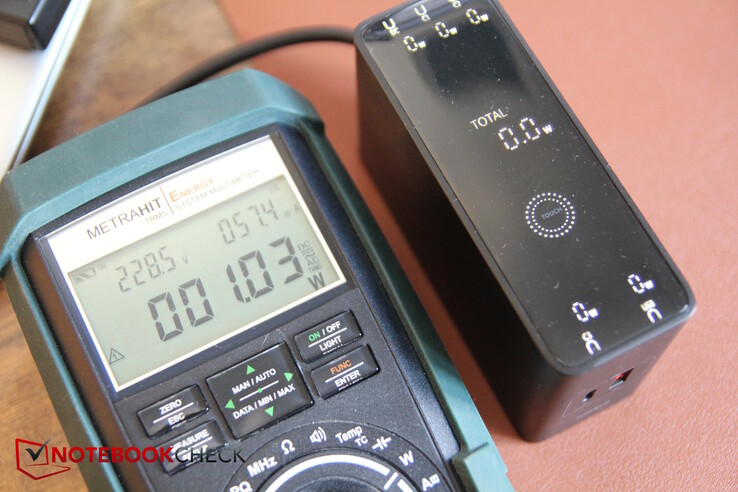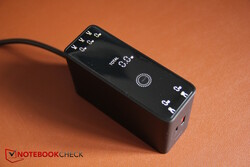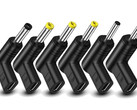Baseus 240 W hands-on: Universal GaN charger with display for up to 5 devices
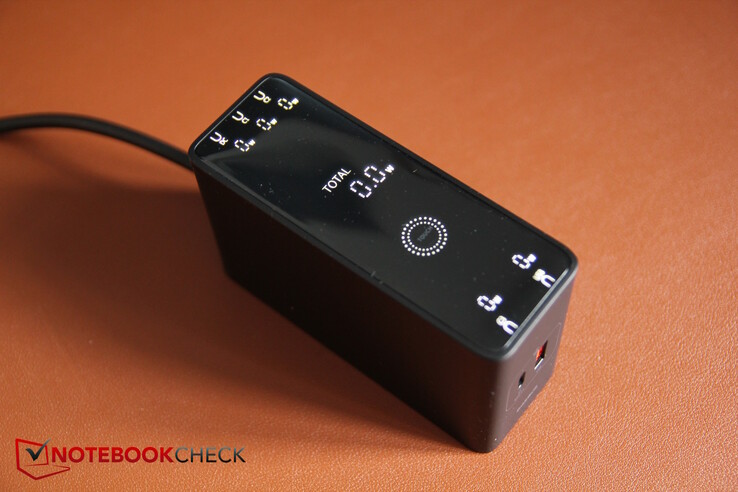
The 240 watts of the Baseus USB power supply can potentially even charge gaming laptops reliably. However, the Baseus should not only be used to power one device but as many devices as possible at once on the desk. Various adapters and cables ensure this. The practical display, which can be switched off, shows how much the connected devices are consuming and also the total power consumption. We measure how accurate this is and whether the 190 euros are worth it.
The company Baseus primarily manufactures accessories, was founded in China in 2009, and is a brand under the umbrella of Shenzhen Times Innovation Technology.
Case: Compact charger with fixed power cable
The power supply unit sits in a compact, pleasantly small, sturdy black plastic housing. The display with a touch-sensitive point is located on the top of the charger, and the entire surface is made of smooth (acrylic) glass. The entire underside is rubberized so the USB adapter has a good grip on a flat surface.
Without the additional cable but with the integrated power cable, the adapter weighs around 615 grams.
Connections
Technical specifications - 240 W only via DC, otherwise shared
The product is listed as a compact 5-port 240W desktop charger. In German, the packaging reads "Digital intelligent desktop GaN fast charger". The gallium nitride (GaN) used for some time now instead of the more traditional silicon ensures smaller power dimensions and less heat generation. The power supply supports the Power Delivery 3.1 fast charging standard (140 W PD 3.1, 100 W PD 3.0).
As an input, the power supply can handle anything between 110 and 240 V, making it suitable as a travel companion.
Its 5 quick-charging outputs (3x USB-C, 1x USB-A, 1x DC) can therefore supply a total of 5 devices with up to 240 W total power. However, it is important to note that 240 W is only provided individually via the DC port, and even then only when a single device is connected! If two laptops (or alternative devices) are connected to the charger via DC and USB-C, they can only draw 140 W via DC and 100 W via USB-C. A single laptop can only draw 140 W via USB-C, two laptops 140 W and 100 W, and so on - see screenshot below. With more than one device connected via USB, the total power of 240 W is therefore distributed across at least two of the outputs. There are already USB-C power supply units on the market that can also supply 240 W at one output.
The USB-A port has a maximum output power of 30 W, so there are various possible combinations of port usage and a corresponding distribution of the maximum 240 W.
The "touch display" is also widely advertised. However, this is an exaggeration, as the touch functionality is limited to a circular area the size of a fingerprint that you can press to (de)activate the display. There are no more touch functions, nor do we need them.
The charger's display shows the output power in watts above each of the 5 outputs. In addition, the total power "TOTAL" is shown in the center. This is very practical as you can also see the consumption of the respective devices at a glance (at least in theory - see below).
Of course, this calls for a function to track this consumption over time. The universal power supply actually supports Bluetooth and can be connected to an app from Baseus, which is used to control the power supply. Unfortunately, it is not really possible to record a consumption curve, but more on this in the next section.
Baseus app
The free Baseus app can be found in the App Store or Play Store. After a quick installation, you will be asked whether you want to create an account or continue as a guest. In the latter case, some functions may allegedly be missing.
However, we created an extra account but couldn't find any additional functions. At most, these might be easier access to support. So you can save yourself the trouble of creating an account for the time being.
Authorizations
The app potentially requests various authorizations. These include the location, which must be activated for pairing with the power supply unit via Bluetooth BLE. Unfortunately, the location is also recorded when the application is closed. You are unlikely to lose the power supply unit on your desk at home, which is why a tracking function seems semi-useful.
In addition, absurd and unnecessary permissions such as the camera and microphone are also requested for the power supply to function.
Functions
Essentially, the main screen only shows the total consumption and the temperature of the power supply unit, and you can also switch the display and the device as a whole on and off here.
However, the app has a few additional functions in the menus. For example, you can activate a timer for the outputs so that devices at the respective outputs are switched on or off at a specific time.
However, we are missing one useful function: consumption tracking.
Although you can display a consumption graph for each output of the charger, this does not have any information on the unit of time in the X-axis, and the selected time section is only a few seconds long, so you can't even see how high the consumption was 10 seconds ago.
Average, maximum, and minimum values are also not displayed, and there is no possibility to save or export data. That's a pity, but maybe the feature will be added in the future.
As a result, the timer function for each output is probably the most useful feature of the app, and otherwise, you can ignore it.
Accessories and warranty
In addition to the power supply unit and a really small mini manual, there are also a few small stickers and various cables and adapters in the packaging: a 1 m long USB-C cable designed for 240 W and a 1 m long DC cable with a round plug, which can be converted into a smaller or thinner round plug or a rectangular plug using two other enclosed adapter cables:
- 1x DC (5.5mm) to DC (5.5mm) 240W fast charging cable (1 m)
- 1x DC (5.5mm) to DC (4.5mm) adapter cable
- 1x DC (5.5mm) to rectangular plug adapter cable
- 240W USB-C to USB-C cable (1 m)
With a total of 4 USB ports, we would have liked at least one more USB-C cable that is designed for 140 or at least 100 W. The selection of DC plugs could also have been wider. For example, our Alienware 13 R3 requires a thicker round plug. So you have to find the cables for the other 3 connections yourself or buy them separately.
Practical test: The display data in the measured value comparison
We chose several devices for our practical test: The gaming laptop Gigabyte Aorus 15G for the DC connection (otherwise has a 230 W round plug power supply), the recently tested HP EliteBook 865 G10 for the USB-C port (otherwise has a USB-C power supply with 110 W), plus LED lights for the USB-A port and a smartphone for charging.
Test 1 - One gaming laptop at the DC output
Our Aorus gaming laptop consumes just over 200 W in the stress test, but load peaks of up to 256 W are also possible.
First of all, we noticed that the display starts to flash, both for the individual value and the total value, when the consumption approaches the critical maximum values for the power supply unit.
It is also noticeable that the consumption with the Baseus power supply unit appears to be higher than with the standard 230W power supply unit on the one hand and fluctuates significantly more on the other.
Last but not least, the stress test with Furmark and Prime95 is too much for the Baseus charger. Our subsequent test with the standard power supply shows a fairly constant consumption of just over 200 W (multimeter), but according to the Baseus display, the 240 W are regularly exceeded and the device switches off the output, the laptop power is throttled in battery mode, then the power supply output is switched on again and the cycle starts all over again.
Our multimeter shows less fluctuating values, which are usually slightly below 240 W, but the Baseus cannot maintain operation at the limit.
Test 2 - Two laptops connected to DC and USB-C
Now we run the gamin laptop in idle mode and simultaneously connect the EliteBook via USB-C (max. 140 W + 100 W possible). The stress test now only runs on the latter. Short-term load peaks of 101 W were possible in the test, but on average, the EliteBook consumes around 70 to 80 W in the stress test.
The setup is no problem for the Baseus charger. The situation is different when we also start Prime95 on the gaming laptop. This should cost around 120 W and still leave room for the 140 W maximum output. And so it is - the power supply starts to flash again, and according to the display, 140 W is sometimes exceeded. The input is not switched off immediately, but we are close to the limit, and a switch-off cannot be ruled out if the test lasts longer.
Test 3 - Four devices on various connections
In the final test, we connect our smartphone and our LED backlights. The laptops first run in idle mode, and then we stress the EliteBook a little.
The Baseus supplies all devices with power but only delivers a maximum of 20 W to the second laptop (EliteBook, C2), at least on C2 (see screenshot 1 + 2). If we switch the connections so that our smartphone is connected to C2 and the EliteBook to C1, the laptop can consume up to 60 W (see screenshot 3). When connecting several devices, you should therefore pay attention to which output each device is connected to.
The smartphone (Huawei Mate 20 Pro) is supplied with 17 W, even in the subsequent test alone. The LED lights only consume 3 to 9 W.
Results
We were able to determine several things in the test:
- The consumption display of the Baseus charger fluctuates significantly more than that on our multimeter and in some cases incredibly strongly. For example, our gaming laptop allegedly consumed only 4 W or even 1 W at idle on the DC. The information on the display is, therefore, a guide value at best.
- With connected devices that come close to the maximum values (gaming laptop connected to DC), the Baseus quickly displays values that exceed the limits and switches off the output, even though the multimeter indicates that there is still some room.
- When connecting several power-hungry devices, you should pay attention to the port order, as in case of doubt C1 already provides more power than C2, and so on.
If you do not come close to the limit values, the Baseus is well suited to supplying several devices with power at the same time. At the same time, it is questionable whether the expensive power supply can really keep to its own maximum specifications or, as indicated by the multimeter, goes to its knees a little too early.
Standby consumption
The display in particular, but also the Bluetooth function for the app connection, naturally also consumes power. We take a look at how high the standby consumption is.
When the display is switched off, the connected Baseus power supply still requires an average of 0.92 W, virtually in standby mode. If the display is active, the consumption increases minimally to just over 1 W. The display is, therefore, less of a consumer here, but Bluetooth and the internal electronics are. Meanwhile, the desktop charger itself naturally displays 0 W, as no consumer devices are connected.
Pros
Cons
Verdict: Practical charger, but better not to test the limit values
The Baseus 240 W Digital GaN charger is practical for supplying several (USB) devices with power from a single, relatively small, and compact power supply unit. In the best-case scenario, this saves you from the need to use several power supply units and various long cables while also allowing you to keep an eye on consumption. The charger is also well equipped for traveling with 110 to 240 V.
Overall, however, we are a little disappointed. We cannot tap 240 W at one of the USB ports - this is only possible at the DC port. The display fluctuates and provides indicative rather than accurate readings at best, switches off earlier than the limit values would allow, at least according to the multimeter, and the standby consumption could also be a little lower. In addition, the app does not allow consumption to be recorded, which is perhaps a good thing in view of the inaccurate (display) data.
In practice, you may rarely encounter problems, at least without a gaming laptop, and the device is certainly practical. However, for around 190 euros, you could certainly expect more accuracy.
With the Baseus 240 W Digital GaN, you can conveniently supply up to 5 devices with just one charger. This works well if you don't come close to the specified limits, but 240 W works at best at the DC port. In view of the price, however, various functions would have deserved more optimization.
Price and availability
The Baseus power supply is not yet available in Germany, but this is set to change soon. Even on the Baseus website, the 240 W power supply is not yet listed among the products, although it can already be seen on the cover picture of the website.
However, the Baseus Desktop Charger has long been available in various import stores, for example at Aliexpress for around 190 euros or at Amazon.com for around 170 US dollars after deducting a 30-dollar coupon, but not yet on Amazon.de.
Transparency
The selection of devices to be reviewed is made by our editorial team. The test sample was given to the author by the manufacturer free of charge for the purposes of review. There was no third-party influence on this review, nor did the manufacturer receive a copy of this review before publication. There was no obligation to publish this review. As an independent media company, Notebookcheck is not subjected to the authority of manufacturers, retailers or publishers.
This is how Notebookcheck is testing
Every year, Notebookcheck independently reviews hundreds of laptops and smartphones using standardized procedures to ensure that all results are comparable. We have continuously developed our test methods for around 20 years and set industry standards in the process. In our test labs, high-quality measuring equipment is utilized by experienced technicians and editors. These tests involve a multi-stage validation process. Our complex rating system is based on hundreds of well-founded measurements and benchmarks, which maintains objectivity. Further information on our test methods can be found here.




